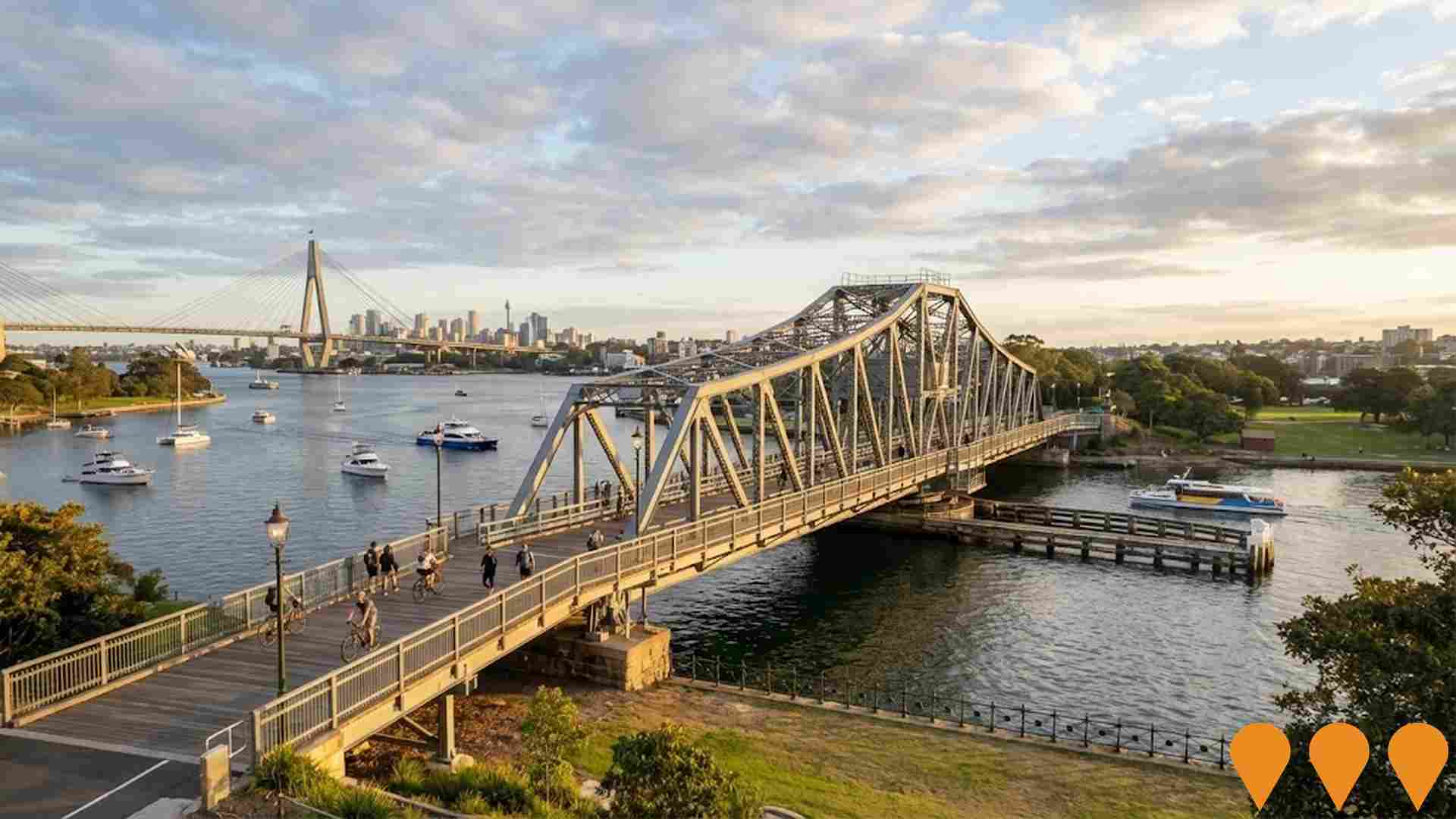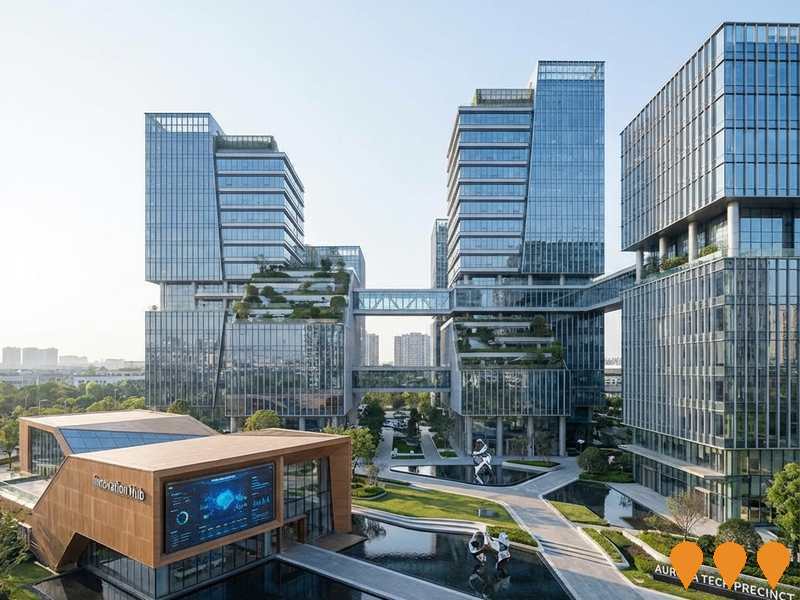Chart Color Schemes
est. as @ -- *
ABS ERP | -- people | --
2021 Census | -- people
Sales Activity
Curious about local property values? Filter the chart to assess the volume and appreciation (including resales) trends and regional comparisons, or scroll to the map below view this information at an individual property level.
Find a Recent Sale
Sales Detail
Population
Pyrmont has seen population growth performance typically on par with national averages when looking at short and medium term trends
Pyrmont's population is around 13,976 as of November 2025. This reflects an increase of 1,318 people since the 2021 Census, which reported a population of 12,658. The change was inferred from the estimated resident population of 13,958 from the ABS in June 2024 and an additional 19 validated new addresses since the Census date. This level of population equates to a density ratio of 15,028 persons per square kilometer, placing Pyrmont in the top 10% of national locations assessed by AreaSearch, indicating high demand for land in the area. Pyrmont's growth rate of 10.4% since the 2021 Census exceeded both the state (6.7%) and metropolitan area rates, marking it as a growth leader in the region. Overseas migration contributed approximately 89.0% of overall population gains during recent periods.
AreaSearch adopts ABS/Geoscience Australia projections for each SA2 area, released in 2024 with 2022 as the base year. For areas not covered by this data, AreaSearch utilises NSW State Government's SA2 level projections, released in 2022 with 2021 as the base year. Growth rates by age group from these aggregations are applied to all areas for years 2032 to 2041. Based on latest population numbers, a significant increase is forecasted for Pyrmont, with an expected rise of 4,116 persons to 2041, reflecting a total increase of 29.3% over the 17 years.
Frequently Asked Questions - Population
Development
Residential development activity is lower than average in Pyrmont according to AreaSearch's national comparison of local real estate markets
Pyrmont has seen virtually no dwelling approvals in recent years. Over the past five financial years, from FY21 to FY25, only one home was approved, with none yet approved in FY26. This low supply is significant given that an average of 32 new residents per year have arrived per dwelling constructed during this period.
Consequently, demand substantially outstrips supply, leading to heightened buyer competition and pricing pressures. Meanwhile, commercial development approvals total $24.5 million in the current financial year, indicating moderate levels of commercial development. Compared to Greater Sydney, Pyrmont's building activity is notably lower, further strengthening demand and prices for existing properties. This scarcity of new homes is also below national averages, suggesting maturity in the area and possible planning constraints.
Frequently Asked Questions - Development
Infrastructure
Pyrmont has very high levels of nearby infrastructure activity, ranking in the top 10% nationally
Twenty-two projects identified by AreaSearch are expected to impact the area significantly, with major changes to local infrastructure influencing performance greatly. Key projects include The Star Sydney - Ritz-Carlton Hotel & Lyric Theatre, Pyrmont Place, The Bays Metro Station & Precinct, and Pyrmont Metro Station & Over Station Development. The following list details those likely to be most relevant.
Professional plan users can use the search below to filter and access additional projects.
INFRASTRUCTURE SEARCH
 Denotes AI-based impression for illustrative purposes only, not to be taken as definitive under any circumstances. Please follow links and conduct other investigations from the project's source for actual imagery. Developers and project owners wishing us to use original imagery please Contact Us and we will do so.
Denotes AI-based impression for illustrative purposes only, not to be taken as definitive under any circumstances. Please follow links and conduct other investigations from the project's source for actual imagery. Developers and project owners wishing us to use original imagery please Contact Us and we will do so.
Frequently Asked Questions - Infrastructure
New Sydney Fish Market
The NSW Government is delivering a purpose-built new Sydney Fish Market at Blackwattle Bay designed by 3XN with BVN and Aspect Studios. The c. 26,000 sqm facility will house retail, restaurants and bars, fishmongers and wholesale auction facilities, new wharf and boating infrastructure, and a continuous public foreshore promenade. Construction is nearing completion with government indicating building completion and handover to the operator in late 2025, with public opening scheduled for 19 January 2026. The project is expected to attract over 6 million visitors annually.
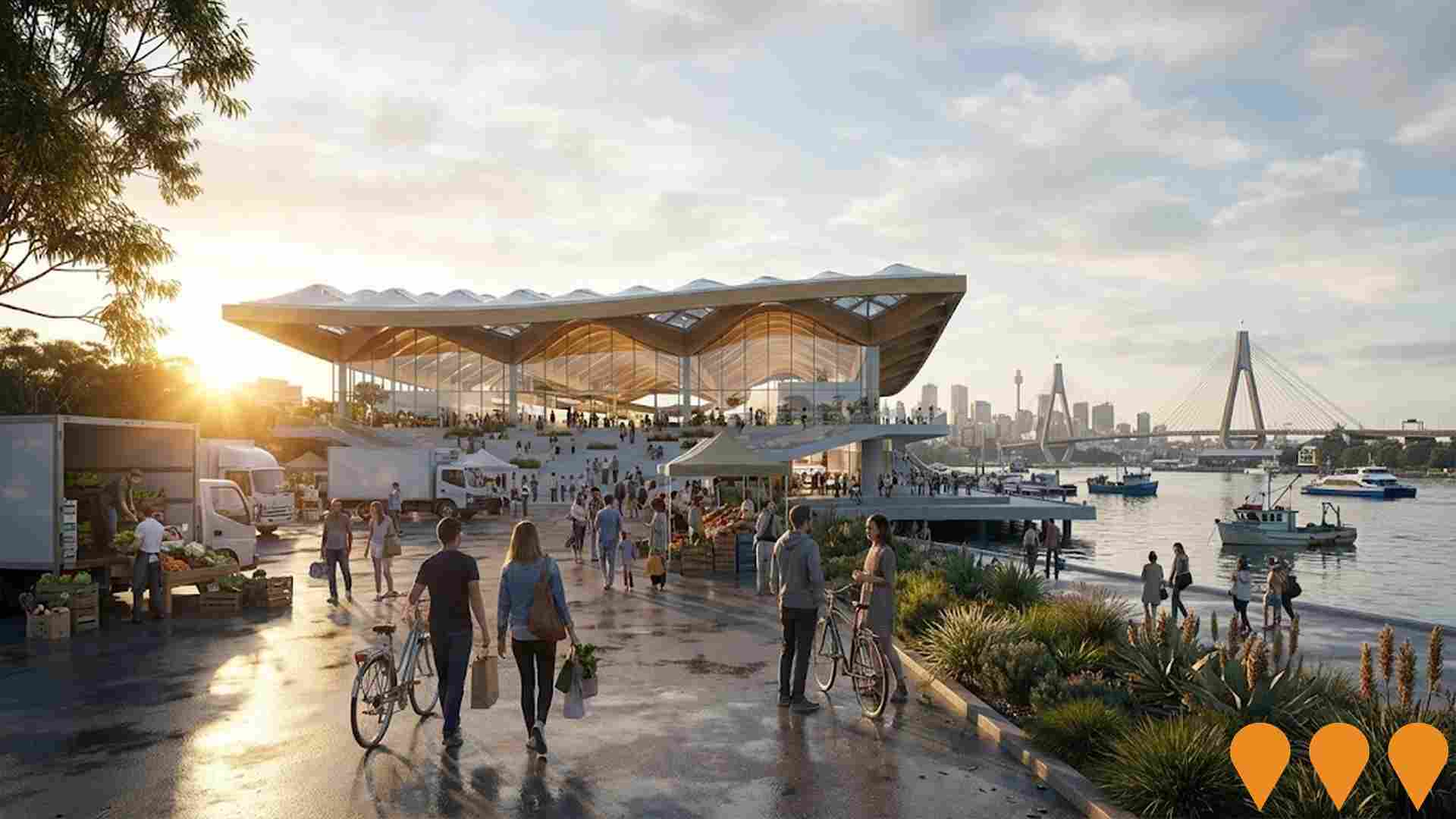
The Bays Metro Station & Precinct
The Bays Metro Station is part of the Bays West Transit Orientated Development (TOD) precinct, which will create a new urban centre with residential, commercial, and retail spaces connected to the Sydney Metro West line. The precinct rezoning is set to deliver more well-located homes.
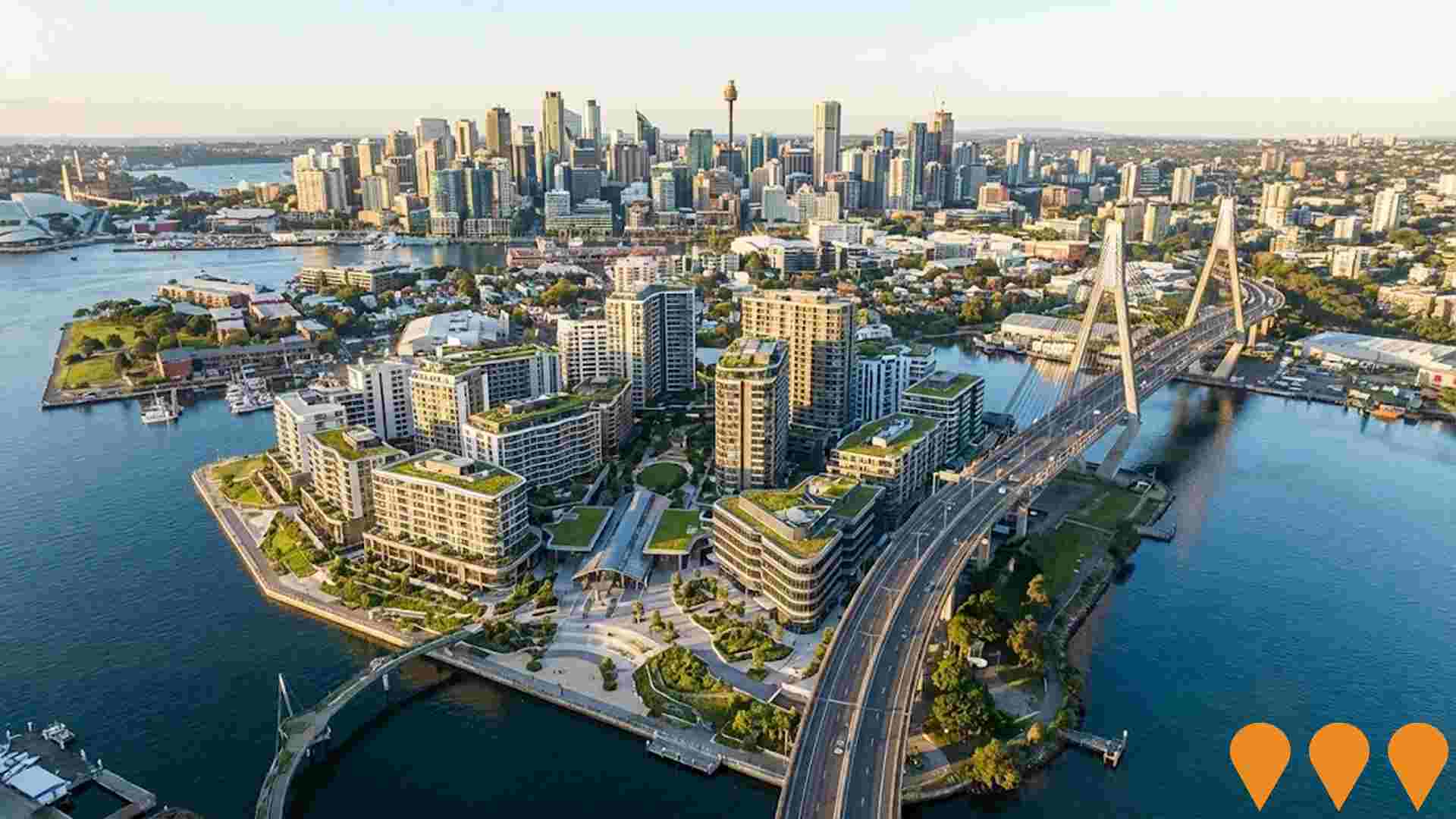
Pyrmont Peninsula Place Strategy
The Pyrmont Peninsula Place Strategy is the NSW Government's 20-year vision for Pyrmont Peninsula. Endorsed in May 2022 and finalised in December 2022, it guides urban renewal of the peninsula into a vibrant, innovative, mixed-use precinct with up to 4,000 new homes, capacity for 23,000 additional jobs, new public spaces, improved transport and delivery of key infrastructure including a new Sydney Metro West station at Pyrmont.

Pyrmont Metro Station & Over Station Development
New underground Sydney Metro West station at Pyrmont with integrated over-station development. The station forms part of the 24km Metro West line between Westmead and The Bays. A 31-storey mixed-use tower above the station (SSD-52585731) includes 160 apartments, retail and commercial floor space. Station cavern excavation complete, TBMs arrived July 2025, platform and station fit-out underway. Over-station development construction expected to commence 2026.
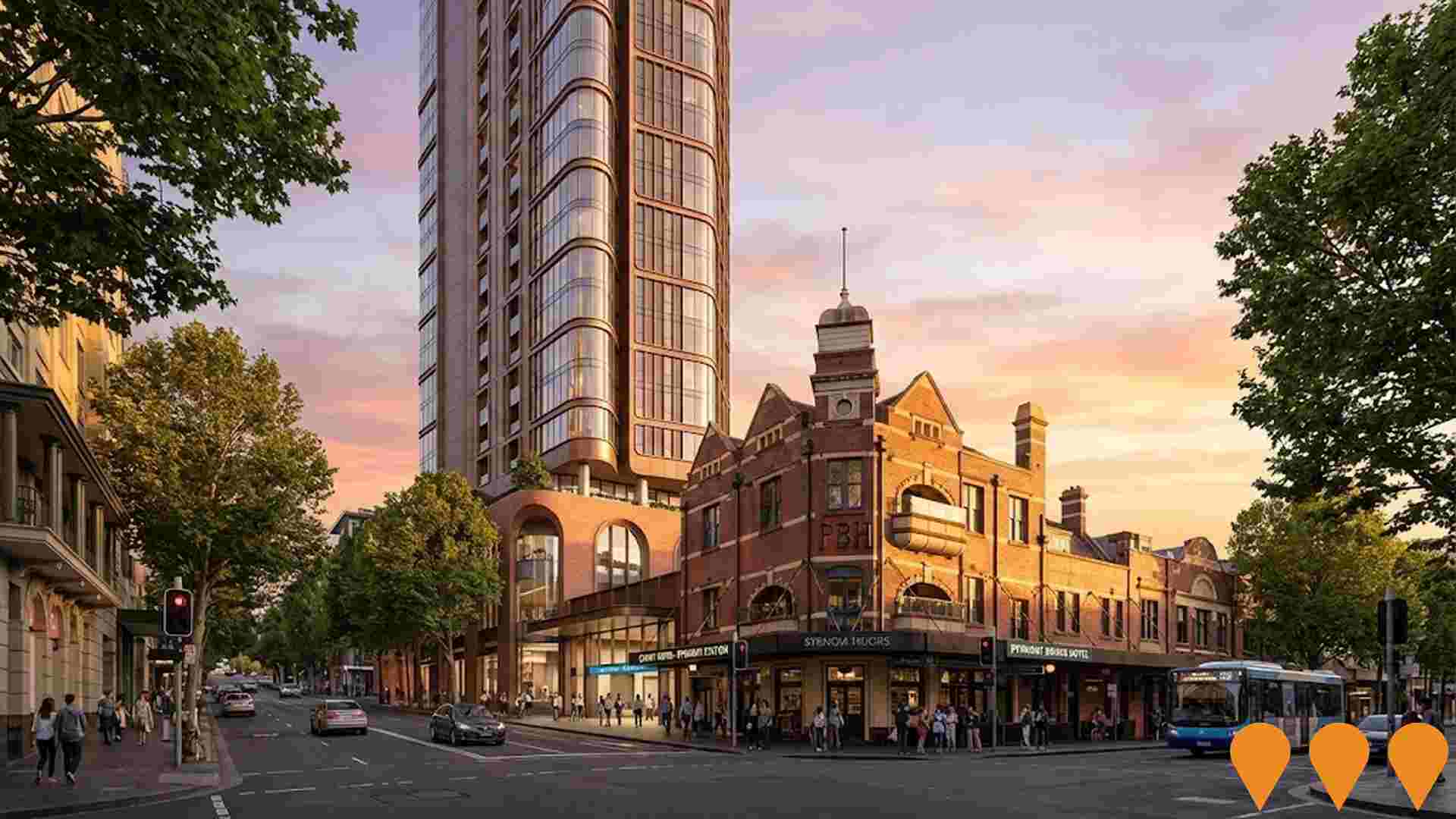
The Star Sydney - Ritz-Carlton Hotel & Lyric Theatre
66-storey Ritz-Carlton luxury hotel and residential tower (237 hotel rooms + 153 residential apartments) and new 1550-seat Lyric Theatre at The Star Sydney. Construction commenced in 2024 with main tower works expected to reach ground level by late 2025. The existing Event Centre and Lyric Theatre were sold to Foundation Theatres in January 2025 and will be converted into three new performance venues opening late 2025. Hotel and new theatre expected completion 2029.
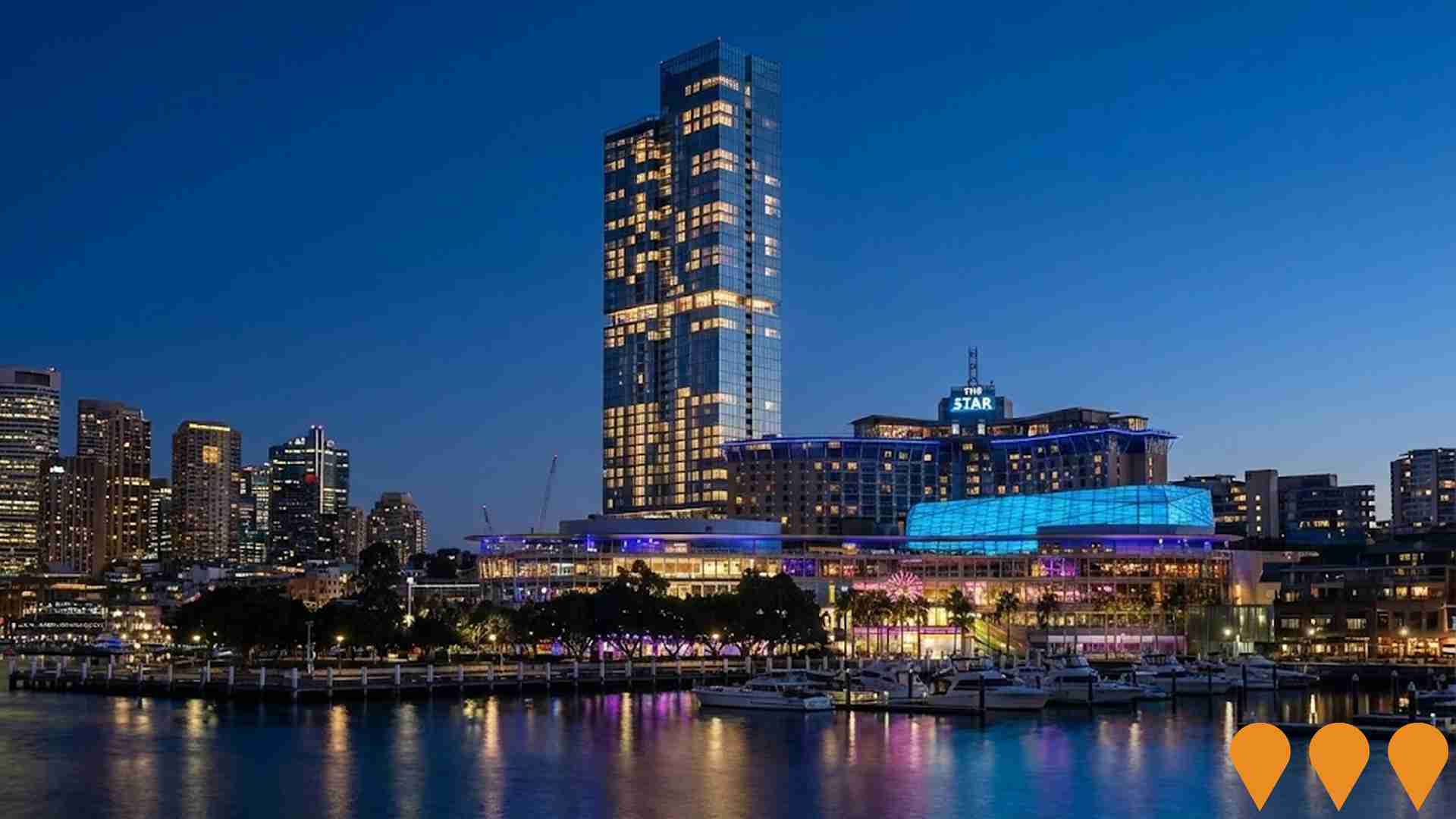
Powerhouse Ultimo Renewal
Major renewal and expansion of the Powerhouse Museum (Museum of Applied Arts and Sciences) in Ultimo. The project delivers new exhibition and education spaces, a 2,000 sqm public plaza on The Goods Line, rooftop venues, improved pedestrian links, heritage restoration of the Ultimo Powerhouse building, and adaptive reuse of the former Harwood building.
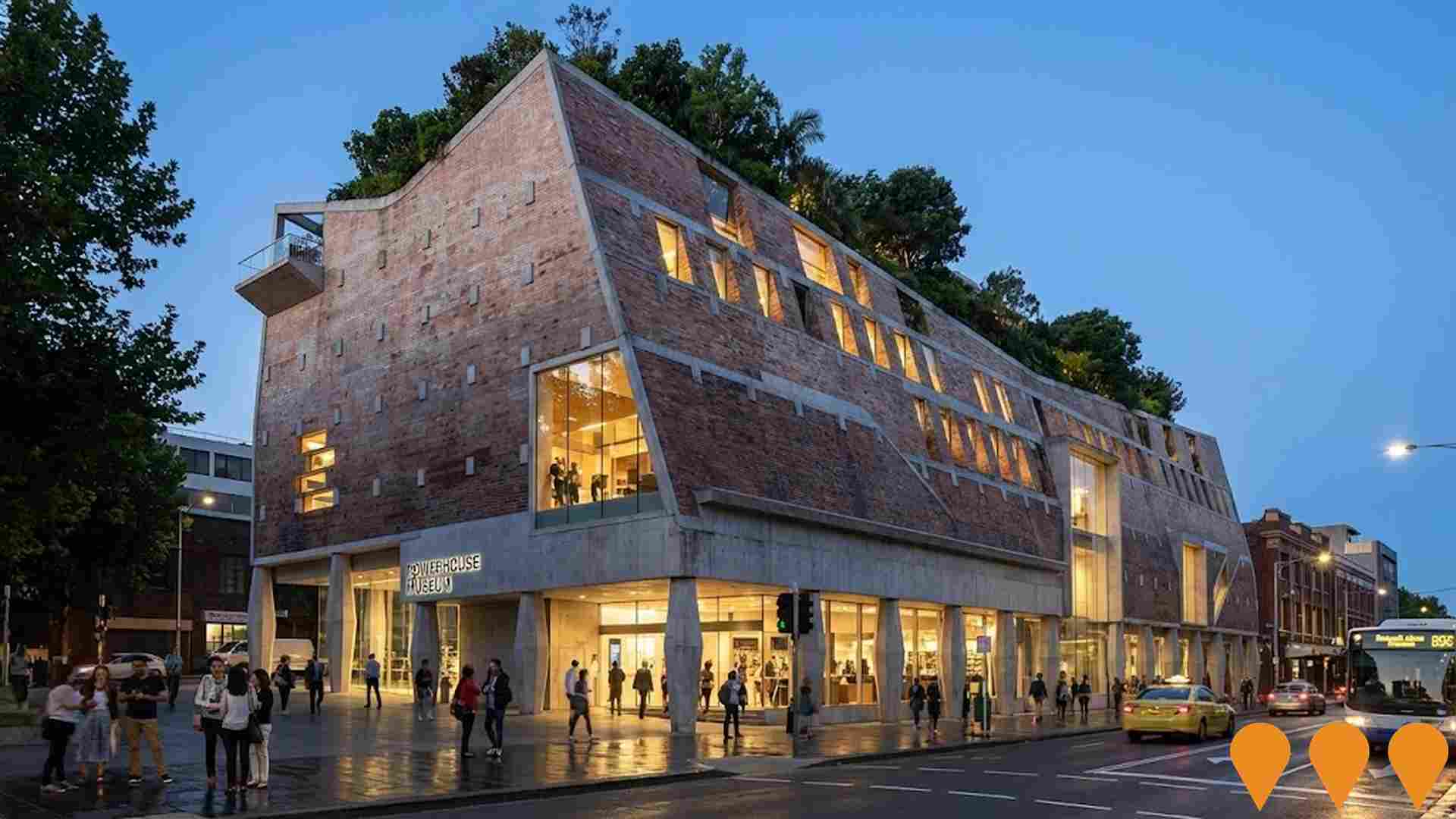
Cockle Bay Park (Cockle Bay Wharf Redevelopment)
State-significant mixed-use redevelopment of Cockle Bay Wharf delivering a 183-metre commercial office tower with approximately 75,000 sqm premium office space, 14,000 sqm retail and dining precinct, and 10,000 sqm of new elevated public parkland bridging the Western Distributor to reconnect the Sydney CBD with Darling Harbour.
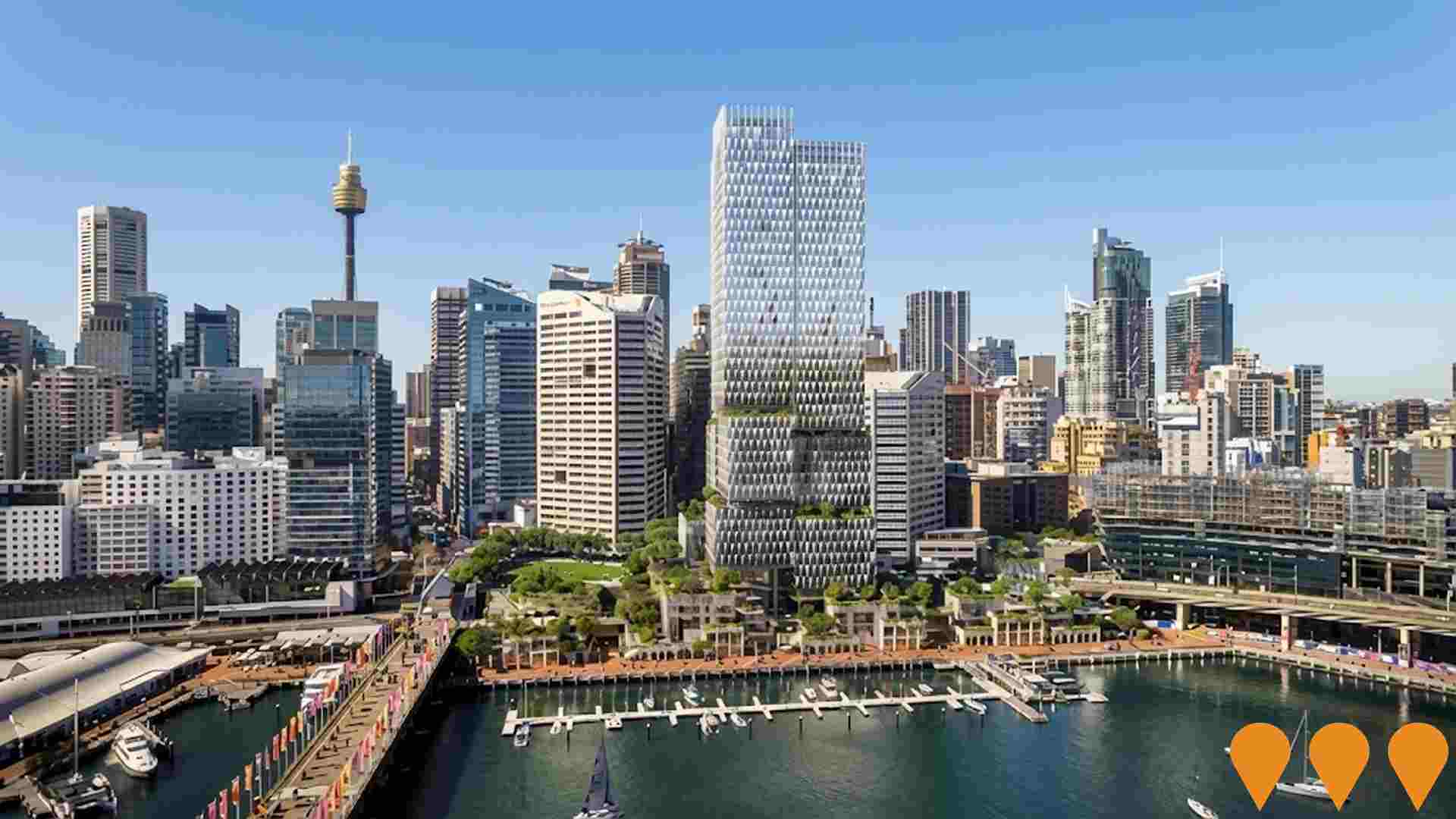
Pyrmont Place
A $900 million mixed-use urban renewal development featuring 237 luxury apartments and penthouses across three residential towers, a commercial building, a 91-place childcare facility, a recreation centre with two indoor sports courts, and communal amenities like a pool, gym, and landscaped areas in the Pyrmont Peninsula. The project has received Stage 2 DA approval from the City of Sydney Council. Construction is expected to commence in mid-2025 with completion anticipated in early 2028.

Employment
AreaSearch assessment positions Pyrmont ahead of most Australian regions for employment performance
Pyrmont has a highly educated workforce with notable representation in the technology sector. Its unemployment rate was 3.1% as of June 2025, which is 1.1 percentage points lower than Greater Sydney's rate of 4.2%.
Workforce participation in Pyrmont stands at 67.0%, compared to Greater Sydney's 60.0%. The dominant employment sectors among residents include professional & technical services, finance & insurance, and accommodation & food services. Pyrmont shows strong specialization in professional & technical services, with an employment share of 180% of the regional level. Conversely, health care & social assistance has limited presence at 7.8%, compared to 14.1% regionally.
As of the Census, there are 1.5 workers for every resident in Pyrmont, indicating its role as an employment hub hosting more jobs than residents and attracting workers from surrounding areas. Between June 2024 and June 2025, employment levels increased by 0.4% while labour force grew by 0.6%, causing the unemployment rate to rise by 0.2 percentage points in Pyrmont. In comparison, Greater Sydney recorded employment growth of 2.6%, labour force growth of 2.9%, and an unemployment rate increase of 0.3 percentage points during the same period. Jobs and Skills Australia's national employment forecasts from May 2025 project a 6.6% expansion in employment over five years and 13.7% over ten years nationally. Applying these projections to Pyrmont's employment mix suggests local growth of approximately 7.3% over five years and 14.4% over ten years, though these are simple weighted extrapolations for illustrative purposes and do not account for localised population projections.
Frequently Asked Questions - Employment
Income
Income metrics indicate excellent economic conditions, with the area achieving higher performance than 75% of national locations assessed by AreaSearch
Pyrmont's income level is among the top percentile nationally according to latest ATO data aggregated by AreaSearch for financial year 2022. Pyrmont's median income among taxpayers is $63,456 and average income stands at $105,118, compared to Greater Sydney's figures of $56,994 and $80,856 respectively. Based on Wage Price Index growth of 12.61% since financial year 2022, current estimates would be approximately $71,458 (median) and $118,373 (average) as of September 2025. Census 2021 income data shows household, family and personal incomes all rank highly in Pyrmont, between the 89th and 95th percentiles nationally. Income brackets indicate 30.6% of the population (4,276 individuals) fall within the $1,500 - 2,999 income range, reflecting patterns seen in the region where 30.9% similarly occupy this range. Higher earners represent a substantial presence with 41.8% exceeding $3,000 weekly, indicating strong purchasing power within the community. High housing costs consume 20.1% of income, though strong earnings still place disposable income at the 82nd percentile and the area's SEIFA income ranking places it in the 9th decile.
Frequently Asked Questions - Income
Housing
Pyrmont features a more urban dwelling mix with significant apartment living, with above-average rates of outright home ownership
Pyrmont's dwelling structure, as per the latest Census, consisted entirely of non-household dwellings such as apartments and semi-detached units. This contrasts with Sydney metropolitan areas where 2.3% were houses and 97.7% other dwellings. Home ownership in Pyrmont stood at 18.3%, higher than Sydney's average. Mortgaged dwellings accounted for 18.5% while rented properties made up 63.2%. The median monthly mortgage repayment was $2,800, above the Sydney metro average of $2,705. Median weekly rent in Pyrmont was $580 compared to Sydney's $550. Nationally, Pyrmont's mortgage repayments were significantly higher than the Australian average of $1,863 and rents substantially exceeded the national figure of $375.
Frequently Asked Questions - Housing
Household Composition
Pyrmont features high concentrations of group households and lone person households, with a higher-than-average median household size
Family households constitute 57.4% of all households, including 15.9% couples with children, 33.1% couples without children, and 7.0% single parent families. Non-family households account for the remaining 42.6%, with lone person households at 33.0% and group households comprising 9.6%. The median household size is 2.1 people, larger than the Greater Sydney average of 1.9.
Frequently Asked Questions - Households
Local Schools & Education
Pyrmont shows strong educational performance, ranking in the upper quartile nationally when assessed across multiple qualification and achievement indicators
Educational attainment in Pyrmont is notably high. 59.3% of residents aged 15+ have university qualifications, compared to national (30.4%) and NSW state (32.2%) averages. Bachelor degrees are the most common at 37.0%, followed by postgraduate qualifications (18.8%) and graduate diplomas (3.5%). Vocational pathways account for 21.3% of qualifications, with advanced diplomas at 11.7% and certificates at 9.6%.
Educational participation is high, with 27.2% currently enrolled in formal education. This includes 7.6% in tertiary education, 4.5% in primary education, and 3.6% pursuing secondary education. Schools appear to be located outside Pyrmont's immediate boundaries, requiring residents to access educational facilities in neighboring areas.
Frequently Asked Questions - Education
Schools Detail
Nearby Services & Amenities
Transport
Transport servicing is high compared to other areas nationally based on assessment of service frequency, route connectivity and accessibility
Pyrmont has 30 active public transport stops. These include ferries, light rail, and buses. There are five routes serving these stops, providing a total of 3,824 weekly passenger trips.
The average distance from residents to the nearest stop is 123 meters. On average, there are 546 trips per day across all routes, which equals about 127 weekly trips per individual stop.
Frequently Asked Questions - Transport
Transport Stops Detail
Health
Pyrmont's residents boast exceedingly positive health performance metrics with very low prevalence of common health conditions across all age groups
Health outcomes data shows excellent results across Pyrmont, with very low prevalence of common health conditions across all age groups. The rate of private health cover is exceptionally high at approximately 74% of the total population (10,300 people), compared to 69.7% across Greater Sydney and a national average of 55.3%. The most common medical conditions in the area are asthma and mental health issues, impacting 5.7% and 5.7% of residents respectively, while 79.1% declare themselves completely clear of medical ailments compared to 77.4% across Greater Sydney.
The area has 14.3% of residents aged 65 and over (1,999 people), which is higher than the 9.7% in Greater Sydney. Health outcomes among seniors are particularly strong, broadly in line with the general population's health profile.
Frequently Asked Questions - Health
Cultural Diversity
Pyrmont is among the most culturally diverse areas in the country based on AreaSearch assessment of a range of language and cultural background related metrics
Pyrmont has a high level of cultural diversity, with 43.1% speaking a language other than English at home and 56.2% born overseas. Christianity is the predominant religion in Pyrmont, comprising 37.0%. However, Buddhism is notably overrepresented, making up 7.0%, compared to 7.1% across Greater Sydney.
In terms of ancestry, the top three groups are Other (18.4%), English (16.8%), and Chinese (14.6%). Some ethnic groups show notable differences: Spanish is overrepresented at 1.3% in Pyrmont versus 1.0% regionally, Russian at 1.1% versus 0.8%, and French at 1.0% versus 1.1%.
Frequently Asked Questions - Diversity
Age
Pyrmont's population is slightly younger than the national pattern
Pyrmont's median age is 37, matching Greater Sydney's figure of 37 and closely resembling Australia's median age of 38. The 25-34 age group comprises 25.8% of Pyrmont's population, higher than Greater Sydney's percentage but lower than the national average of 14.5%. The 5-14 age cohort makes up 5.2% of Pyrmont's population. Between 2021 and present, the 15 to 24 age group has grown from 7.9% to 9.7%, while the 75 to 84 cohort increased from 3.5% to 4.9%. Conversely, the 55 to 64 age group decreased from 10.5% to 9.3% and the 0 to 4 age group dropped from 4.8% to 3.7%. By 2041, demographic projections indicate significant changes in Pyrmont's age structure. Notably, the 25 to 34 age group is projected to grow by 95%, reaching 7,042 people from its current figure of 3,605. Meanwhile, both the 45 to 54 and 35 to 44 age groups are expected to decrease in number.


